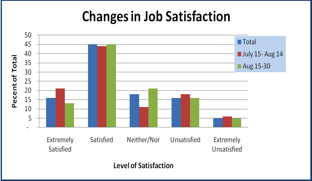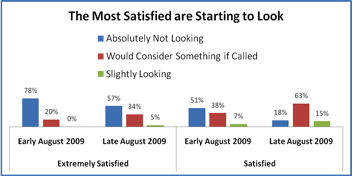Over the past few months, I’ve been tracking employee satisfaction vs. job hunting activity. Here’s the link so you can take the survey yourself, see the results, and forward it to others.
The idea here is that by tracking changes in satisfaction and the job-hunting activity level for the fully employed, we’ll have a leading indicator of employment churn.
Fully employed people switching positions with other fully employed people doesn’t do much for the national employment rate, but it can still keep a recruiting department extremely active. This employment churn becomes a problem when a company is forced to find a bunch of new hires to replace a significant number of tenured employees who have left voluntarily. This becomes a really big problem when it’s unanticipated and when it’s a company’s best people. Replacing them is then even more difficult.
The underlying cause of employee churn is similar to any financial or real estate bubble — greed, or the feeling of not wanting to be left behind. On the hiring side it’s nothing more than a few people getting better jobs, which leads to more people getting more active and finding better jobs, which in turn leads to even more activity, and so on, until you have a tidal wave or avalanche effect.
On the job-hunting side, it’s obvious that once a few new jobs are created, those who are fully employed, but most dissatisfied with their current jobs, will jump ship first. As these people are replaced, it will create a wave of job-hunting activity for those slightly less dissatisfied, and as these positions are replaced, even more people will start sensing the economy is recovering, and begin looking as well.
This churn will accelerate rapidly, as the pent-up demand for better jobs and salary increases is unleashed.
Based on our survey results, this could happen sooner than expected. These surveys are starting to indicate a decline in overall job satisfaction coupled with increased job hunting activity. None of this job switching will affect the overall employment rates, but this replacement activity will force corporate recruiting departments to gear up their activity level at a rapid rate. Things will be much worse if these replacement hires haven’t been forecasted.
The accompanying chart shows the decline in satisfaction over the six-week period from mid July to late August.
 What’s most surprising is the decline is from the group of people who indicated just a few weeks earlier that they were extremely satisfied with their jobs. This has dropped from 21% to 13% in just a few weeks.
What’s most surprising is the decline is from the group of people who indicated just a few weeks earlier that they were extremely satisfied with their jobs. This has dropped from 21% to 13% in just a few weeks.
Those who indicated they were satisfied didn’t change much, with the biggest pickup in those who indicated they were neither satisfied nor unsatisfied with their jobs. This increased from 11% to 21%. Essentially, 40% of the group who were initially very satisfied with their jobs no longer feel this way.
What happened in two to three short weeks to cause this decline?
It could very well be that as the economy has begun to recover and opportunities have started reappearing, just having a job is no longer good enough.
So people are getting itchy and are starting to do some preliminary searching.
While a hypothesis right now, we should be able to get confirmation of this by conducting a cross-question analysis comparing job-hunting activity by level of satisfaction. The results from this analysis are still preliminary, but this trend is quite apparent and is shown in the graph titled, “The Most Satisfied are Starting to Look.”
 As part of the survey, we asked respondents to describe their current job-hunting activity level. The choices ranged from not looking to aggressively looking. In early August, 78% of the extremely satisfied said they were absolutely not looking. This dropped to 57% by the end of August.
As part of the survey, we asked respondents to describe their current job-hunting activity level. The choices ranged from not looking to aggressively looking. In early August, 78% of the extremely satisfied said they were absolutely not looking. This dropped to 57% by the end of August.
A similar drop was noted for those who classified themselves as being satisfied with their jobs, dropping from 51% who were absolutely not looking to just 18%. As you can see by the graph, there was also a major increase in both groups who indicated they would consider something if called by a recruiter.
This drop in job satisfaction in combination with an increased level of job-hunting activity is a strong indicator that employment churn is about to increase dramatically in the next month or two. If this is the case, you’d better get ready right away.
Here are some ideas to consider:
- Rebuild your recruiting team. If you don’t have enough recruiters to handle the load, you’ll get behind long before the recovery really starts. Then you’ll never be able to catch up.
- Conduct your own internal satisfaction survey to validate these results and pinpoint your most vulnerable areas. While the survey results are reasonably statistically valid, they’re not specific enough to uncover specific problem areas by industry or job function. Many companies are now aggressively launching internal satisfaction surveys to ensure they’re not caught unaware. This way, they’ll minimize the impact of any potential retention problems.
- Accelerate your sourcing efforts for your most critical positions. You’ll need to begin an aggressive recruitment advertising effort for those positions that seem most critical and where you are most vulnerable. If you’re a corporate recruiting leader, you might want to use your employee referral program and get everyone to provide you the names of the best people they’ve ever worked with anywhere. Then contact these people and put them in your talent pool. (Here’s a recorded webinar we did showing how you can use LinkedIn to accelerate this effort.)
- Learn to use hiring ROI to justify to your CFO the cost of any new recruiting or sourcing program. If you’re going to be hiring a bunch of new people before your company’s hiring forecast is approved, you’ll need a creative approach to justify any expenditures. I’m preparing a white paper on a new approach to calculate ROI by measuring the impact any new hiring initiative has on changing a company’s overall talent mix. Email me if you’d like a sneak peak. Here’s a recent article with some background on this important topic.
While it will be a rocky road to recovery, the replacement market is likely to heat up first, and soon.
If you get behind the power curve in these early next few months it will be very difficult to ever catch up. New sourcing technologies offer great new techniques to find the best, but don’t forget: they’ve never been tested in a hot market where the demand for talent exceeds the supply. Some forward planning and some big contingency programs will get you through the worst of it, if employment churn accelerates faster than anticipated.